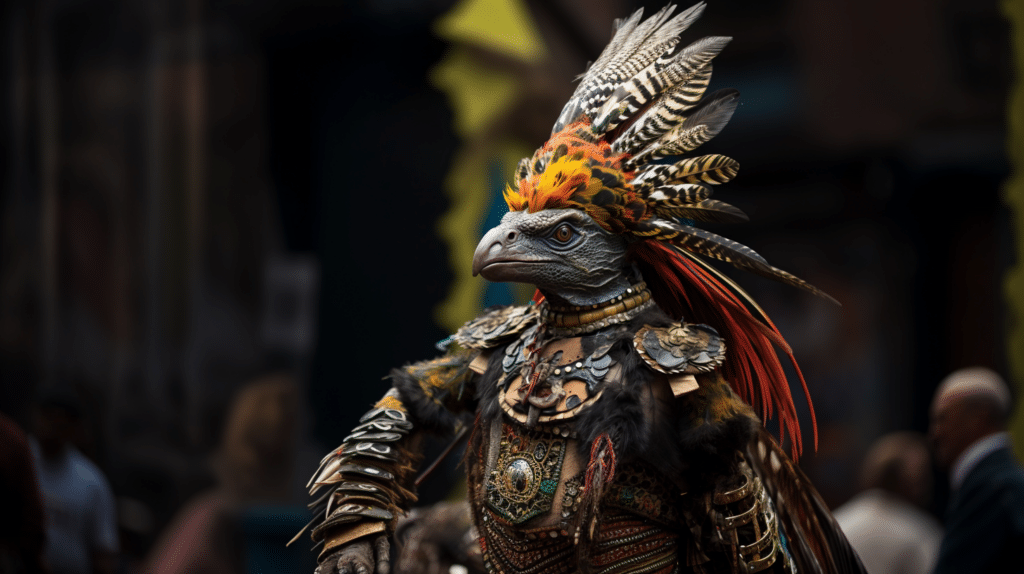
Unveiling the History of Serpent Legends
By GZR News on January 9, 2024
The Ancient Origins of Serpent Folk
Mythical Creatures in Ancient Civilizations
The serpent has long been a symbol of power and mystery in ancient civilizations. From the Egyptian god Apep, who represented chaos and destruction, to the Greek monster Python, who guarded the oracle at Delphi, serpents have captured the imagination of people throughout history. In Hinduism, the Naga are serpent-like beings associated with water and fertility. They are often depicted as half-human, half-serpent creatures with multiple heads. These ancient myths and legends have inspired countless stories and continue to fascinate us today. Into the Parabnormal with Jeremy Scott.
Serpent Gods in Mesopotamian Mythology
Mesopotamian mythology is rich with tales of powerful serpent gods. One of the most prominent is Tiamat, the primordial goddess of the saltwater ocean. She is often depicted as a massive, serpentine creature with multiple heads and a fierce temperament. Tiamat is known for her role in the creation myth, where she battles against the younger gods in a cosmic struggle for power. Another notable serpent god is Ningishzida, who is often depicted as a serpent with a human head. He is associated with fertility, healing, and the underworld. In Mesopotamian culture, serpent gods were revered and feared, representing both chaos and divine power.
Legends of the Naga in Hinduism
In Hinduism, the naga is a fascinating mythical creature that holds great significance. It is depicted as a half-human, half-cobra being, representing the duality of nature. The naga is often associated with water and is believed to have the power to control rain and bring fertility to the land. According to Hindu mythology, the naga is also considered a guardian of treasures and is often depicted as coiled around a lingam, a symbol of Lord Shiva. The naga’s association with Lord Shiva further emphasizes its divine nature and spiritual significance.

Serpent Folk in Medieval Folklore
Dragons in European Folktales
European folklore is rich with tales of dragons, majestic creatures that have captured the imaginations of people for centuries. These mythical beasts are often depicted as large, winged reptiles with the ability to breathe fire. They are known for their immense strength and ferocity, and are often portrayed as guardians of treasure or powerful adversaries to be defeated by brave knights. In many European cultures, dragons symbolize power, wisdom, and the eternal struggle between good and evil.
The Basilisk: King of Serpent Folk
In European bestiaries and legends, a basilisk is a legendary reptile reputed to be a serpent king, who causes death to those who look into its eyes. The basilisk is often depicted as a small snake or a rooster with a snake’s tail. Its gaze is said to be deadly, capable of killing with a single glance. According to folklore, the basilisk’s venom is so potent that it can kill plants and animals just by touching them. This fearsome creature has been a popular subject in European folklore and literature for centuries.
The Wyrm: Serpent of the British Isles
The Wyrm is a legendary creature that has been a part of British folklore for centuries. It is often depicted as a giant serpent or dragon-like creature with scales and a long, winding body. According to legend, the Wyrm was said to inhabit deep caves and underground tunnels, emerging only to wreak havoc on the land. It was believed to have the power to control the weather and cause storms and floods. The Wyrm was also said to guard hidden treasures and was often associated with ancient burial sites and sacred places. Its fearsome reputation made it a popular subject in medieval tales and legends.

Serpent Folk in World Religions
The Serpent in Abrahamic Religions
In Abrahamic religions, the serpent is often associated with temptation and evil. In the Book of Genesis, the serpent tempts Eve to eat the forbidden fruit, leading to the fall of humanity. This story has been interpreted as a cautionary tale about the consequences of disobedience. The serpent’s role as a symbol of evil is further reinforced in other religious texts, such as the Quran and the Talmud. However, some scholars argue that the serpent also has positive connotations in these religions. For example, in the Kabbalah, the serpent represents wisdom and spiritual transformation. The Secret Teachings with Ryan Gable explores these complex interpretations of the serpent in Abrahamic religions and delves into the hidden symbolism behind this enigmatic creature.
The Dragon in Chinese Mythology
In Chinese mythology, the dragon holds a special place as a symbol of power, wisdom, and good fortune. Dragons are revered creatures that are believed to bring blessings and protect against evil spirits. They are often depicted as long, serpentine creatures with scales and sharp claws. The dragon is a central figure in Chinese culture, appearing in art, literature, and celebrations. It is also associated with the emperor, representing imperial power and authority. The dragon’s significance in Chinese mythology cannot be overstated.
The Feathered Serpent in Mesoamerican Cultures
In Mesoamerican cultures, the Feathered Serpent holds a prominent place in mythology and religion. Known as Quetzalcoatl in Aztec mythology and Kukulkan in Mayan mythology, this deity is depicted as a serpent with feathers. The Feathered Serpent is associated with creation, fertility, and wisdom. It is believed to have brought knowledge and civilization to the ancient Mesoamerican civilizations. The worship of the Feathered Serpent was widespread, and temples dedicated to this deity can still be found in archaeological sites such as Teotihuacan and Chichen Itza.

Serpent Folk in Modern Pop Culture
Dragons in Fantasy Literature
Dragons have long been a staple in fantasy literature, captivating readers with their majestic and fearsome presence. These mythical creatures are often depicted as powerful, fire-breathing beasts, guarding treasure or terrorizing villages. From J.R.R. Tolkien’s Smaug in ‘The Hobbit’ to George R.R. Martin’s dragons in ‘A Song of Ice and Fire,’ dragons have become iconic symbols of fantasy worlds. They represent both danger and wonder, embodying the untamed forces of nature. Whether they are allies or adversaries, dragons continue to captivate readers and fuel their imaginations.
Serpent Folk in Movies and TV Shows
The fascination with serpent folk has extended to the world of movies and TV shows. These mythical creatures have captured the imagination of filmmakers and have been featured in various forms of media. From classic films like “Clash of the Titans” to modern TV shows like “Game of Thrones,” serpent folk have become iconic characters in popular culture. They are often portrayed as powerful and mysterious beings, capable of both great good and great evil. Their serpentine appearance and ability to breathe fire or control the elements make them visually striking and captivating to watch on screen.
The Influence of Serpent Folk in Video Games
Video games have long been fascinated with the mythical creatures known as serpent folk. These creatures, often depicted as powerful and mysterious beings, have made their way into numerous video game titles, captivating players with their unique abilities and lore. From the iconic dragons of The Elder Scrolls series to the serpent-like creatures in Dark Souls, serpent folk have become a staple in the world of gaming. Their presence adds an element of fantasy and adventure, allowing players to immerse themselves in rich and imaginative worlds.
Serpent Folk in Modern Pop Culture is a fascinating topic that explores the presence of these mythical creatures in today’s entertainment industry. From movies to books to video games, the influence of serpent folk can be seen in various forms. Whether it’s the iconic serpent-like villains in fantasy novels or the mesmerizing serpent creatures in blockbuster films, these mythical beings continue to captivate audiences worldwide.
If you’re intrigued by the allure of serpent folk and want to dive deeper into their significance in modern pop culture, look no further than Aftermath Media. As the ultimate resource for parapolitics, UFO’s, and conspiracies, Aftermath Media provides a wealth of information and analysis on these intriguing topics. Visit our website to explore articles, videos, and podcasts that delve into the fascinating world of serpent folk and other captivating subjects. Join our community of like-minded individuals and uncover the secrets that lie beneath the surface of modern pop culture.

In Conclusion
The legends of the Serpent Folk have left a trail throughout history, captivating the imaginations of people across cultures and generations. From ancient civilizations to modern folklore, these mythical creatures have been depicted in various forms, from fearsome dragons to wise serpents. While the origins of these legends may remain shrouded in mystery, their influence on human culture is undeniable. Whether viewed as symbols of power, wisdom, or malevolence, the Serpent Folk continue to fascinate and inspire. So the next time you come across a story or artwork featuring these legendary creatures, remember the rich history and symbolism behind them.
Frequently Asked Questions
What are serpent folk?
Serpent folk are mythical creatures that are often depicted as humanoid snakes or reptilian beings. They can be found in various mythologies and folklore around the world.
Are serpent folk real?
Serpent folk are purely mythical creatures and do not exist in reality. They are a product of human imagination and storytelling.
What is the origin of serpent folk legends?
The legends of serpent folk have ancient origins and can be traced back to various civilizations and mythologies, such as Mesopotamian mythology, Hinduism, and European folklore.
What is the significance of dragons in mythology?
Dragons are often seen as powerful and mystical creatures in mythology. They symbolize strength, wisdom, and often have a connection to the elements or the divine.
How have serpent folk influenced modern pop culture?
Serpent folk, particularly dragons, have had a significant influence on modern pop culture, especially in fantasy literature, movies, TV shows, and video games.
Are there any real-life creatures that resemble serpent folk?
While there are no real-life creatures that resemble serpent folk exactly, there are some animals, such as snakes and lizards, that may have inspired the mythical depictions of serpent folk.